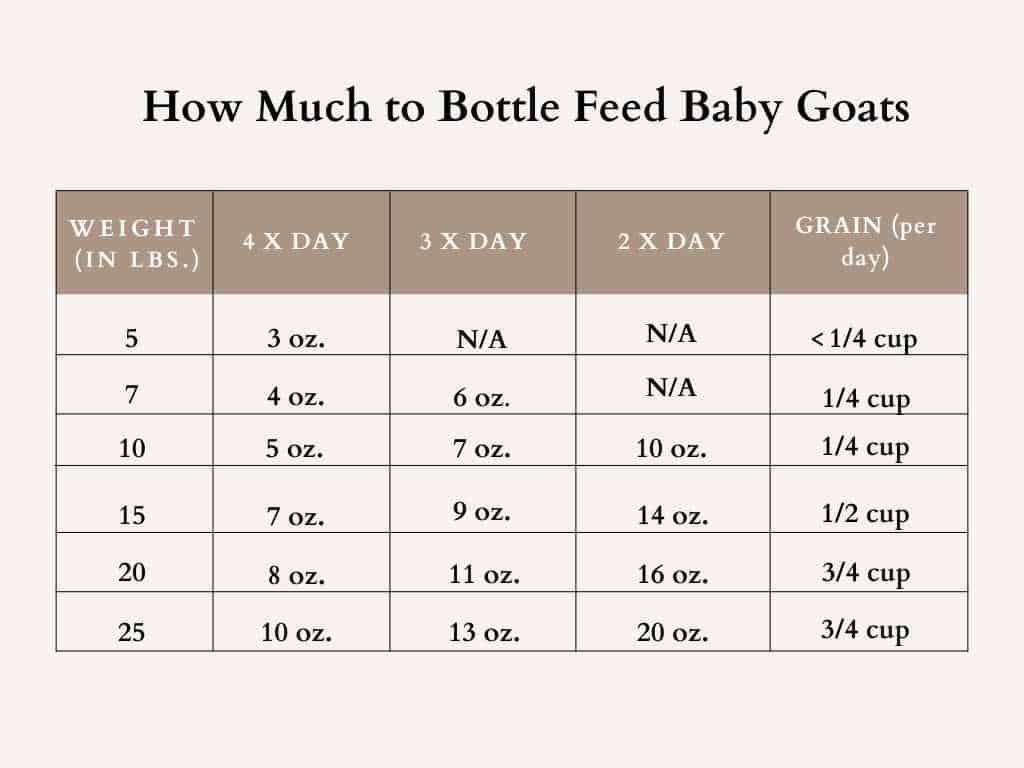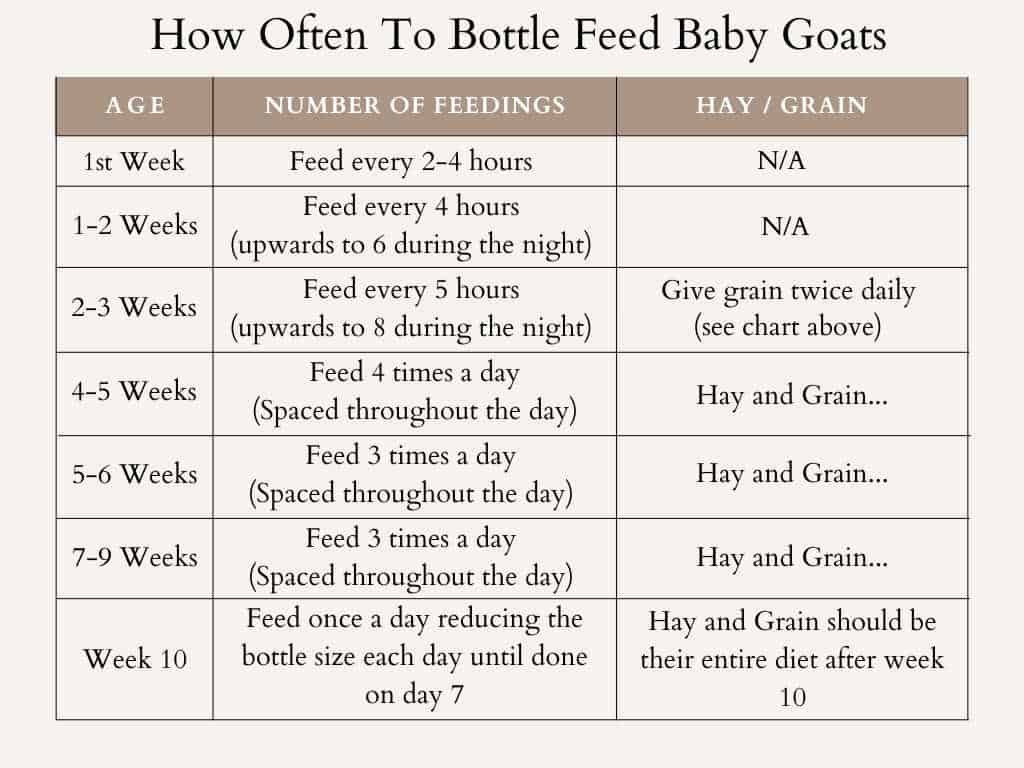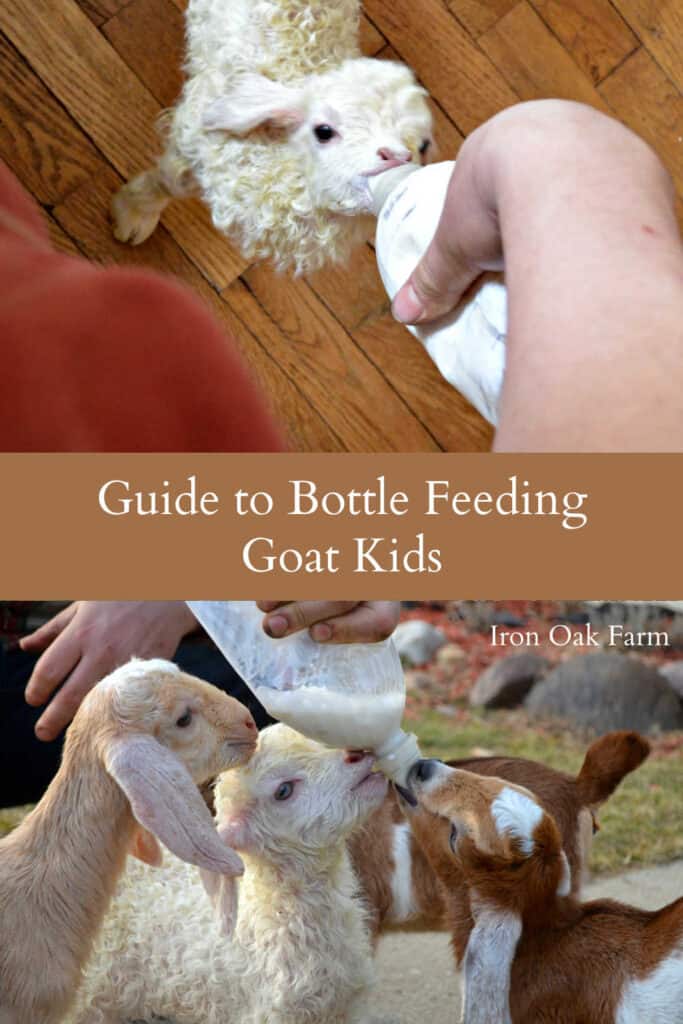Guide to Bottle Feeding Goat Kids
In this guide to bottle-feeding goat kids, I'll show you everything you need to know to successfully bottle-feed a baby goat. Everything from why do it, how to do it and some tricks to entice a reluctant kid.



Why bottle feed kids?
If I'm being honest, it is WAY easier to just let Mama goat take care of her kids. The dam has all the instincts she needs to provide for her babies. When kids are dam raised, caring for Mom is the same as caring for her young kids. If you give Mom everything she needs, she will produce healthy milk and raise her babies well. So why bottle feed? Below are 3 reasons why you might choose to bottle feed.
- Friendly kids- Bottle-raised goats are notoriously more friendly than dam-raised kids. They associate you and the bottle with Mom. They are more cuddly, more likely to come when called, and will have more of the personality of a dog. Dam-raised kids are often more standoffish, will be more challenging to train, and have more of a herd mentality.
- Getting to milk earlier- Some people choose to bottle feed so that they can begin milking their doe earlier. Goats produce a lot more milk than their babies need at one time. Many people will pull the babies, set aside the kid's milk ration, and keep the rest.
- Preventing CAE- Caprine Arthritis Encephalitis (CAE) is a contagious virus among goats. It causes debilitating symptoms like swollen joints, arthritis, and pneumonia, among others. The most common way the disease is spread is from mother to kid through colostrum and milk. (It can also be spread through other bodily fluids). Many farms pull the kids and feed milk replacement as a way to contain the disease, and stop it from affecting future generations.
Other reasons to bottle feed
- The mom rejects the kids- Sometimes you don't have much of a choice as far as bottle feeding. In my experience, this happens more often with dams that were also bottle raised as kids. It's as if they don't know what to do with their babies. With persistence, you can sometimes get them to understand their role as mothers, but oftentimes it's just easier to bottle raise than to struggle with an uncooperative dam. A really stubborn dam can even get aggressive toward her kids.
- Weak babies- Sometimes the babies are too weak to stand and nurse from Mom. In this case, you will need to bottle feed until the kid is strong enough to nurse on its own.
It is extremely important that the kid gets his first drink of colostrum in the first hour to hour-an-a-half of life. After this, the kid will grow weaker and weaker and nursing will become even more difficult.



Types of milk replacer
Unless you are implementing CAE management in your herd (see above), it's best to milk mom and feed her colostrum and milk to her kids. You can pour the warm milk right from her body into a clean, bottle and feed. If the milk is being refrigerated, I recommend heating it to 100-102 degrees F (38-39 degrees C). But if the mom is a reluctant milker or has health issues after birth, it's always good to have some milk replacer on hand.



When we first raised kids, the breeder we got them from recommended feeding whole cows milk. Honestly, this worked fine, the kids were healthy and thrived. Since then, I've done some research and comparison and we now feed:
Manna Pro Kid Colostrum Supplement
Manna Pro Kid Milk Replacer with Probiotics
Both of these contain more protein and additional vitamins and minerals designed for goat kids than whole cow's milk. They also contain probiotics which help prevent scours (diarrhea) due to feeding changes.
If your milk replacer does not contain probiotics then I recommend adding Probios probiotics whenever making any feed changes.



What kind of bottle to use for feeding goat kids?
You don't need any fancy bottle to feed goat kids. We use a clean, 16-20 oz plastic soda bottle fitted with a goat-specific nipple (see below). Soda bottles are made from sturdier plastic than most water bottles.



What kind of nipple to use for feeding goat kids?
Get a nipple meant for lambs and kids. Nipples meant for cows will not work. They are too large and hard to compress for the goat to suckle. You can also use nipples meant for human babies, but I try to look for ones that are longer.
Do you need to sterilize the bottle and nipple after each use?
We do not sterilize our kid's bottles after each use. I wash the bottle and nipple in hot water with a grease-cutting soap like Dawn which will cut through the butterfat residue. Rinse well. Let air dry.
How to warm the bottle
Bottles of milk should be warmed for young kids. Around 100-102 degrees F (38-39 degrees C). Our tap water from the hot water tank is warm enough to heat a bottle. I fill a bowl with the hottest water from our sink and let the bottle sit for about 5 minutes. I'll add more hot water as it cools.
You can also heat a pot of water on the stove and let the bottle sit for 5 minutes or so.
Head position
Having the bottle positioned in the correct way is essential, especially in the beginning. Feeding newborn kids at the wrong angle can cause pneumonia if the milk goes down the trachea. The position that kids drink is somewhat awkward. The head and neck should be in a slight Z position (shown below in yellow). With the head kind of craned over the shoulders. The front legs should be braced, and at a spread stance. Hold the bottle low and at a 45-degree angle. (Notice Mom licking the baby's bottom to encourage nursing.)



Getting a reluctant kid to feed
When you try to get a goat kid to feed from a bottle, you're fighting thousands of years of instinct. Baby goats are programmed to smell their mothers, search out a teat, and drink in a very specific way. Mother goats also have instincts complimenting their kid's instincts; under normal circumstances, these behaviors mesh perfectly, in a life-giving way.
Trying to replace Mom with a plastic nipple can be tricky. To begin, make sure you have the correct nipple size, and a nice warm bottle (see above). If the milk starts to cool as you continue in your attempts, warm it back up.
Bottle feeding
It's nice to have an assistant helping you when trying to bottle feed.
I like to sit on the ground with the kid in my lap. I hold the kid in place with my left arm and position the head in my left hand under the jaw. Then I hold the bottle in my right hand. Gently pry the kid's mouth open and get the bottle inside. Be sure to hold the bottle at a 45-degree angle. The kid will most likely roll the nipple around in its mouth. Try this a few times, and give the shortest squeeze just so the goat gets a taste. Sometimes it needs to taste the milk for the connection to click. Do not squeeze milk down the kid's throat, this can cause pneumonia.



If it's still not working, use or left hand (or an assistants) to scratch the baby's bottom. Mother goats lick their babies' bottoms to encourage them to drink.
You might have to do this quite a few times to get it to click. If the baby gets a couple of sucks, give it a break and try again in 10 minutes. Sometimes the kid will become exhausted trying to learn to suckle.
How much milk should a baby goat get?
Once a baby goat associates the bottle with milk, it will always act hungry. It will do anything to get to the bottle and it will drink too much if you let it. This often leads to scours (diarrhea). If scours occur, reduce the milk by 1 oz. per feeding. Then gradually increase after the stool has returned to normal. A good judge of the correct amount is to let the kid nurse until it takes a break. Offer the bottle once more and when it takes a second break, take away the bottle. Larger breeds of goats may need more milk and may need to be fed more often.
Another way to judge is to look at the kid's abdomen. You want it to be a relatively straight line from shoulder to hip. If the abdomen is bulging out, the kid is getting too much milk. If its abdomen is sinking in excessively between the ribs and hips, gradually increase 1 oz. per feeding.
Below is a handy chart that gives you an idea of how to feed per weight of the goat.



How often do kids need to have a bottle?
As I said above, it is very important that a kid receives his first dose of colostrum within 1-2 hours after being born. As time goes on, the kid will grow weaker and weaker, and may eventually give up and perish. After this, it's important to make sure the kid is fed every 2-4 hours for the first 48 hours. Then you can go for 4-5 hours at night. My husband and I usually take shifts feeding throughout the night. After this first crucial stage, you can gradually start spacing out the feedings.



Shop this post!
Manna Pro Kid Colostrum Supplement
Manna Pro Kid Milk Replacer with Probiotics
Pin it for later!


